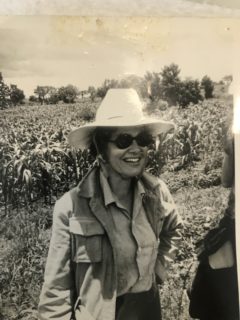Article begins

Image description: A woman stands outside in what appears to be a large field growing rows of vegetables. She is smiling and wears a wide-brimmed hat, sunglasses, a shirt, and jacket.
Caption: Shirley S. Gorenstein
1928‒2020
In her wide-ranging career, Shirley Gorenstein was a Mesoamerican archaeologist, who, after a decade as a faculty member in the Department of Anthropology at Columbia University, founded a public archaeology program at Rensselaer Polytechnic Institute (RPI), in Troy, New York, and later was founding chair of the Department of Science and Technology Studies (STS) at RPI. Throughout these different episodes in her career, she maintained interests in political and military structures of premodern states.
Her fieldwork began when she traveled at the age of 17 to the Kahnawake Reserve in Canada to study Mohawk ironworkers, presenting her paper to the American Ethnological Society in 1946. She graduated from Queens College as an anthropology major (1948), and she earned her MA (1953) and PhD (1963) in anthropology from Columbia University. Both her MA thesis and doctoral dissertation were library-based studies of the development of Mesoamerican and Andean states, from the perspective of their political and military organization.
Once Gorenstein completed her degrees and began teaching at Columbia, she led her first archaeological field project in Mexico. With funding from the National Science Foundation (NSF), she undertook a major study of the Aztec fortress at Tepexi el Viejo, Puebla, in 1965. Published maps were so poor and the site so remote, that it was located with equipment borrowed from the Mexican National Astronomical Observatory. This project led to a monograph in 1973 from the American Philosophical Society, and a major article in American Antiquity in 1971 about historic sources and archaeological evidence from the Mixteca-Puebla region. Both publications have commonly been cited in scholarly publications for the past 50 years. Meanwhile, she has written and edited numerous books and articles on Mesoamerican archaeology.
In 1971, Gorenstein began a second set of field and laboratory projects on the Tarascan side of the Aztec-Tarascan military frontier, focused on locating historically documented fortified sites along the northern frontier of the Aztec empire, in the states of Guanajuato and Michoacán. In 1972‒1973, her the focus was the site of Acámbaro, in Guanajuato. This project was fully published as a monograph in 1985.
Based on Gorenstein’s work on the Tarascan-Aztec frontier, and my dissertation work at the Tarascan capital, Tzintzuntzan, we decided to combine forces in a major project in the core of the Tarascan state, the Lake Pátzcuaro Basin. From 1976 to 1981, Gorenstein directed our project, Development of the Tarascan State: The Lake Pátzcuaro Basin, Michoacán, Mexico. In 1975, we applied for NSF funding but were told to resubmit as a pilot project, as it was doubted that two women could handle a budget at the size and scale that we requested. We resubmitted, and the following year both the NSF and the NEH funded the pilot project. Our research findings were published in an article in Science, a monograph from Vanderbilt University, and chapters in scholarly edited volumes references that have been widely cited in the Mesoamerican archaeology literature.
After founding a public archaeology program at RPI at a time when such programs were not as widespread as they are today, Gorenstein founded the STS department, aligning the RPI anthropology program with the science and engineering focus of the university. As STS chair, she mentored a generation of scholars, many of whom remained close to her throughout her life. She cohosted a conference in 1992 in Phoenix, Arizona, Cultural Dynamics of Pre-Columbian West and Northwest Mexico. The results of this conference were published as Greater Mesoamerica: The Archaeology of West and Northwest Mexico, edited by Michael Foster and Shirley Gorenstein (2000); this book has become one of the foundational volumes for the modern archaeology of West Mexico.
Her husband, Sam, died in 2005. She is survived by her sons, Ethan and Gabriel, daughter-in-law Margee, grandsons Eleazer and Julian, and granddaughters-in-law, Jen and Patti.
(Helen Perlstein Pollard, Ethan Gorenstein, and Gabriel Gorenstein)
Cite as: Pollard, Helen Perlstein, Ethan Gorenstein, and Gabriel Gorenstein. 2021. “Shirley S. Gorenstein.” Anthropology News website, May 6, 2021.

